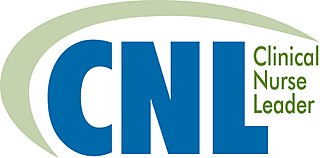Related Research Articles

An emergency department (ED), also known as an accident & emergency department (A&E), emergency room (ER), emergency ward (EW) or casualty department, is a medical treatment facility specializing in emergency medicine, the acute care of patients who present without prior appointment; either by their own means or by that of an ambulance. The emergency department is usually found in a hospital or other primary care center.
A patient is any recipient of health care services performed by healthcare professionals. The patient is most often ill or injured and in need of treatment by a physician, nurse, psychologist, dentist, veterinarian, or other health care provider.
The Joint Commission is a United States-based nonprofit tax-exempt 501(c) organization that accredits more than 22,000 US health care organizations and programs. The international branch accredits medical services from around the world. A majority of US state governments recognize Joint Commission accreditation as a condition of licensure for the receipt of Medicaid and Medicare reimbursements.
Computerized physician order entry (CPOE), sometimes referred to as computerized provider order entry or computerized provider order management (CPOM), is a process of electronic entry of medical practitioner instructions for the treatment of patients under his or her care.

NYC Health + Hospitals, officially the New York City Health and Hospitals Corporation (HHC), operates the public hospitals and clinics in New York City as a public benefit corporation. As of 2012, HHC is the largest municipal healthcare system in the United States with $6.7 billion in annual revenues, serving 1.4 million patients, including more than 475,000 uninsured city residents, providing services interpreted in more than 190 languages. HHC was created in 1969 by the New York State Legislature as a public benefit corporation. It is similar to a municipal agency, but has a board of directors. It operates eleven acute care hospitals, five nursing homes, six diagnostic and treatment centers, and more than 70 community-based primary care sites, serving primarily the poor and working class. HHC's own MetroPlus Health Plan is one of the New York area's largest providers of government-sponsored health insurance and is the plan of choice for nearly half a million New Yorkers.
Patient safety is a discipline that emphasizes safety in health care through the prevention, reduction, reporting, and analysis of medical error that often leads to adverse effects. The frequency and magnitude of avoidable adverse events experienced by patients was not well known until the 1990s, when multiple countries reported staggering numbers of patients harmed and killed by medical errors. Recognizing that healthcare errors impact 1 in every 10 patients around the world, the World Health Organization calls patient safety an endemic concern. Indeed, patient safety has emerged as a distinct healthcare discipline supported by an immature yet developing scientific framework. There is a significant transdisciplinary body of theoretical and research literature that informs the science of patient safety.
A patient safety organization (PSO) is a group, institution, or association that improves medical care by reducing medical errors. Common functions of patient safety organizations are data collection and analysis, reporting, education, funding, and advocacy.
To Err Is Human: Building a Safer Health System is a landmark report issued in November 1999 by the U.S. Institute of Medicine that may have resulted in increased awareness of U.S. medical errors. The push for patient safety that followed its release continues. The report was based upon analysis of multiple studies by a variety of organizations and concluded that between 44,000 to 98,000 people die each year as a result of preventable medical errors. For comparison, fewer than 50,000 people died of Alzheimer's disease and 17,000 died of illicit drug use in the same year.

Clinical Nurse Leader (CNL) is a relatively new nursing role that was developed in the United States to prepare highly skilled nurses focused on the improvement of quality and safety outcomes for patients or patient populations. The CNL is a registered nurse, with a Master of Science in Nursing who has completed advanced nursing coursework, including classes in pathophysiology, clinical assessment, finance management, epidemiology, healthcare systems leadership, clinical informatics, and pharmacology. CNLs are healthcare systems specialists that oversee patient care coordination, assess health risks, develop quality improvement strategies, facilitate team communication, and implement evidence-based solutions at the unit (microsystem) level. CNLs often work with clinical nurse specialists to help plan and coordinate complex patient care.
In healthcare, a change-of-shift report is a meeting between healthcare providers at the change of shift in which vital information about and responsibility for the patient is provided from the off-going provider to the on-coming provider. Other names for change-of-shift report include handoff, shift report, handover, or sign-out. Change-of-shift report is key to inpatient care because healthcare providers are essential to providing around the clock care.
Health Information Technology (HIT) is health technology, particularly information technology, applied to health and health care. It supports health information management across computerized systems and the secure exchange of health information between consumers, providers, payers, and quality monitors. Based on an often-cited 2008 report on a small series of studies conducted at four sites that provide ambulatory care – three U.S. medical centers and one in the Netherlands – the use of electronic health records (EHRs) was viewed as the most promising tool for improving the overall quality, safety and efficiency of the health delivery system. According to a 2006 report by the Agency for Healthcare Research and Quality, broad and consistent utilization of HIT will:

Bar code medication administration (BCMA) is a bar code system designed by Glenna Sue Kinnick to prevent medication errors in healthcare settings and to improve the quality and safety of medication administration. The overall goals of BCMA are to improve accuracy, prevent errors, and generate online records of medication administration.

ECRI is an independent nonprofit organization improving the safety, quality, and cost-effectiveness of care across all healthcare settings worldwide.

The Patient Safety and Quality Improvement Act of 2005 (PSQIA): Pub.L. 109–41, 42 U.S.C. ch. 6A subch. VII part C, established a system of patient safety organizations and a national patient safety database. To encourage reporting and broad discussion of adverse events, near misses, and dangerous conditions, it also established privilege and confidentiality protections for Patient Safety Work Product. The PSQIA was introduced by Sen. Jim Jeffords [I-VT]. It passed in the Senate July 21, 2005 by unanimous consent, and passed the House of Representatives on July 27, 2005 with 428 Ayes, 3 Nays, and 2 Present/Not Voting.
An automated dispensing cabinet (ADC) is a computerized medicine cabinet for hospitals and healthcare settings. ADCs allow medications to be stored and dispensed near the point of care while controlling and tracking drug distribution. They also are called unit-based cabinets (UBCs), automated dispensing devices (ADDs), automated distribution cabinets, automated dispensing machines (ADMs) or pyxis.
Barcode technology in healthcare is the use of optical machine-readable representation of data in a hospital or healthcare setting.
Health care quality is a level of value provided by any health care resource, as determined by some measurement. As with quality in other fields, it is an assessment of whether something is good enough and whether it is suitable for its purpose. The goal of health care is to provide medical resources of high quality to all who need them; that is, to ensure good quality of life, cure illnesses when possible, to extend life expectancy, and so on. Researchers use a variety of quality measures to attempt to determine health care quality, including counts of a therapy's reduction or lessening of diseases identified by medical diagnosis, a decrease in the number of risk factors which people have following preventive care, or a survey of health indicators in a population who are accessing certain kinds of care.

David Bates is an American-born physician, biomedical informatician, and professor, who is internationally renowned for his work regarding the use of health information technology (HIT) to improve the safety and quality of healthcare, in particular by using Clinical Decision Support. Dr. Bates has done especially important work in the area of medication safety. He began by describing the epidemiology of harm caused by medications, first in hospitalized patients and then in other settings such as the home and nursing homes. Subsequently, he demonstrated that by implementing computerized physician order entry (CPOE), medication safety could be dramatically improved in hospitals. This work led the Leapfrog Group to call CPOE one of the four changes that would most improve the safety of U.S. healthcare. It also helped hospitals to justify investing in electronic health records and in particular, CPOE. Throughout his career, Bates has published over 600 peer reviewed articles and is the most cited researcher in the fields of both patient safety and biomedical informatics, with an h-index of 115. In a 2013 analysis published by the European Journal of Clinical Investigation, he ranked among the top 400 living biomedical researchers of any type. He is currently Editor of the Journal of Patient Safety.
In 2002, nursing homes in the United Kingdom were officially designated as care homes with nursing, and residential homes became known as care homes.
The Scottish Patient Safety Programme (SPSP) is national initiative to improve the reliability of healthcare and reduce the different types of harm that can be associated. The programme is co-ordinated by Healthcare Improvement Scotland and is the first example of a country introducing a national patient safety programme across the whole healthcare system. From an initial focus on acute hospitals, the SPSP now includes safety improvement programmes including SPSP Primary care, SPSP Medicines, Maternity and Children Quality Improvement Collaborative (MCQIC) and Mental Health.
References
- 1 2 "Pennsylvania Patient Safety Authority's 2017 Annual Report"
- ↑ "Medical Care Availability and Reduction of Error (MCARE) Act of Mar. 20, 2002, P.L. 154, No. 13". The official website for the Pennsylvania General Assembly. Retrieved 2017-10-24.
- ↑ "Pennsylvania Patient Safety Authority 2014 Annual Report" (PDF).
- ↑ "Medical Care Availability and Reduction of Error (Mcare) Act—reduction and prevention of healthcare-associated infection and long-term care nursing facilities, 2007 Pa. Laws 331, No. 52". The official website for the Pennsylvania General Assembly. Retrieved 2017-10-24.
- ↑ "Pennsylvania Patient Safety Authority 2009 Annual Report" (PDF).
- ↑ "History of the Pennsylvania Patient Safety Authority". Rieders, Travis, Humphrey, Waters & Dohrmann. 2020-05-22. Retrieved 2020-08-24.
- ↑ "Pennsylvania Patient Safety Authority Media Kit" (PDF). Retrieved 2017-10-24.
- ↑ "About the Pennsylvania Patient Safety Advisory". The Pennsylvania Patient Safety Authority. Retrieved 2017-10-24.
- ↑ "National Quality Forum. Past recipients. 2014" . Retrieved 22 Sep 2014.
- ↑ "National Quality Forum. John M. Eisenberg Patient Safety and Quality Awards. 2014" . Retrieved 22 Sep 2014.
- ↑ "The Institute for Safe Medication Practices. Cheers Awards winners [online]" . Retrieved 24 Jan 2014.